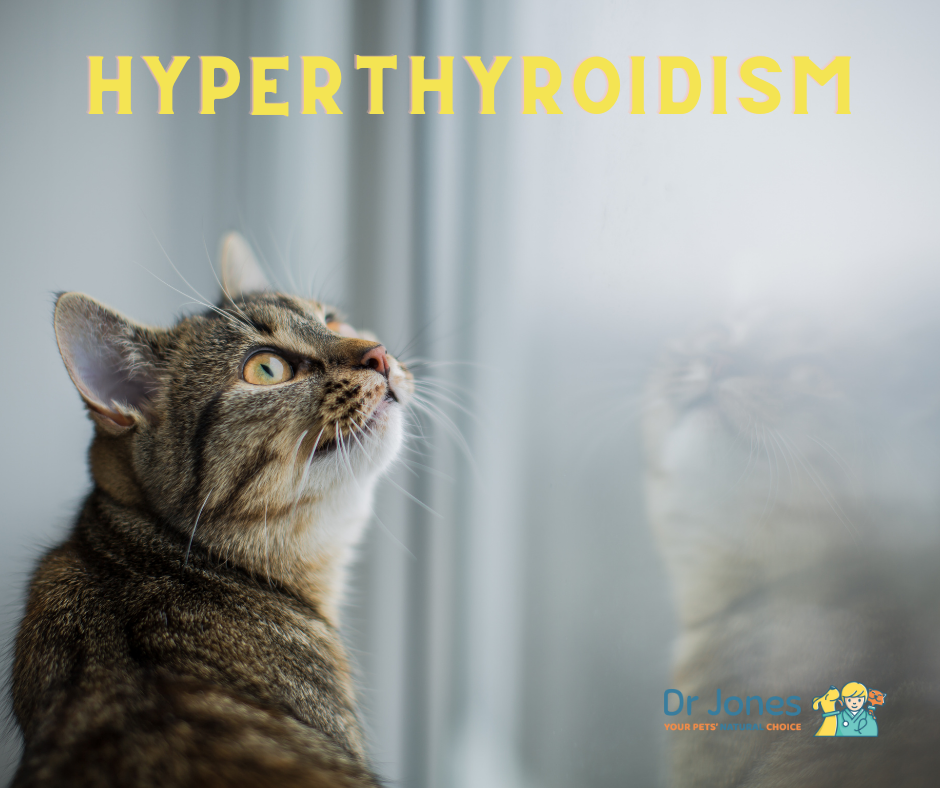Hyperthyroidism

Welcome to part 2 of my thyroid health series – today, I’ll be talking about Hyperthyroidism.
As we learned in Hypothyroidism, the thyroid gland becomes inactive, and slows down metabolism. In the case of Hyperthyroidism, this is the opposite – the thyroid gland becomes overactive.
SIGNS
This is a disease that occurs only in cats, usually older cats.
Some common signs:
- Increased appetite, but will also be losing weight.
- Increased thirst and urination.
- Coat will be sparse, and there may be muscle loss.
- You may be able to feel an enlarged thyroid gland beside Adam’s apple.
- Heart rate will be elevated (greater than 200 beats per minute).
- Blood pressure will be elevated.
- They may experience vomiting or diarrhea.
- Their skin and coat may be matted, greasy and unkempt.
SOLUTIONS
SEE YOUR VET. If your older cat is showing some of these signs, you should have your veterinarian perform blood tests to confirm hyperthyroidism.
RADIOACTIVE IODINE. One of the safest and most effective ways to treat your hyperthyroid cat is with radioactive iodine. Your cat will be given one dose of radioactive Iodine that selectively targets the abnormal thyroid cells.
It requires a specialized licensed facility, and can only be performed at a few referral practitioners.
SURGERY. Surgery is a potential option, but based on the risks of hypocalcemia (when the calcium in the blood is too low), and anesthetic concerns in older cats (who it occurs more often in), it is seldom performed.
CONVENTIONAL MEDICATION. Most cats are treated with a conventional medication called methimazole, but the medication has drawbacks:
First, medication must be given at least daily, usually twice a day. 15% of cats have some type of side effect, typically gastro intestinal (vomiting, diarrhea, lack of appetite).
As well, some can have allergic type reactions. A small percent will have serious liver disease, and some can have their bone marrow affected.
CARNITINE. This is a supplement that has been found to be effective in reversing the signs of hyperthyroid disease in people. The starting cat dose is 250 mg a day.
HERBAL
BUGLEWEED (Lycopus europeus) AND MELISSA (Melissa officinalis). These are two herbs that have been used in combination to combat the effects of hyperthyroid disease.
Bugleweed has been shown to decrease thyroid hormone levels in rats 24 hours after administration. The standard dose is 1 drop per lb of body weight of the tinctures given twice daily.
HEART SUPPORT. If your cat also has a heart murmur, then you can add in these herbs:
Herbal Cardiovascular Tonic
- 1 part Hawthorn, 1 part Dandelion, 1 part Ginkgo
- Dose: 1 ml per 20 lbs of body weight daily of the tincture.
NAT MUR. Thyroid reduction. Alternate practitioners’ favor Nat Mur 30C as the remedy of choice. In fact a clinical trial with this homeopathic gave impressive results, treating the hyperthyroidism in many of the cats. Give 1 tab every 12 hours and assess the response after 30 days.
I hope this helped, please let me know in the comments below what else you’d like me to cover!
I need help in figuring out how to find, buy, assimilate all these ingredients for my cat.
He is allergic to the typical thyroid prescription methimazole. Not a candidate for iodine treatment.
He is not a fan of the thyroid prescription food.
Vet visits do more harm for him than good due to his spicy nature and it’s just not good.
He is holding his weight so far and it’s been one year.
However, his heart rate is super high and he has a heart murmur.
I have to give this herbal method a try!
Can you please help?